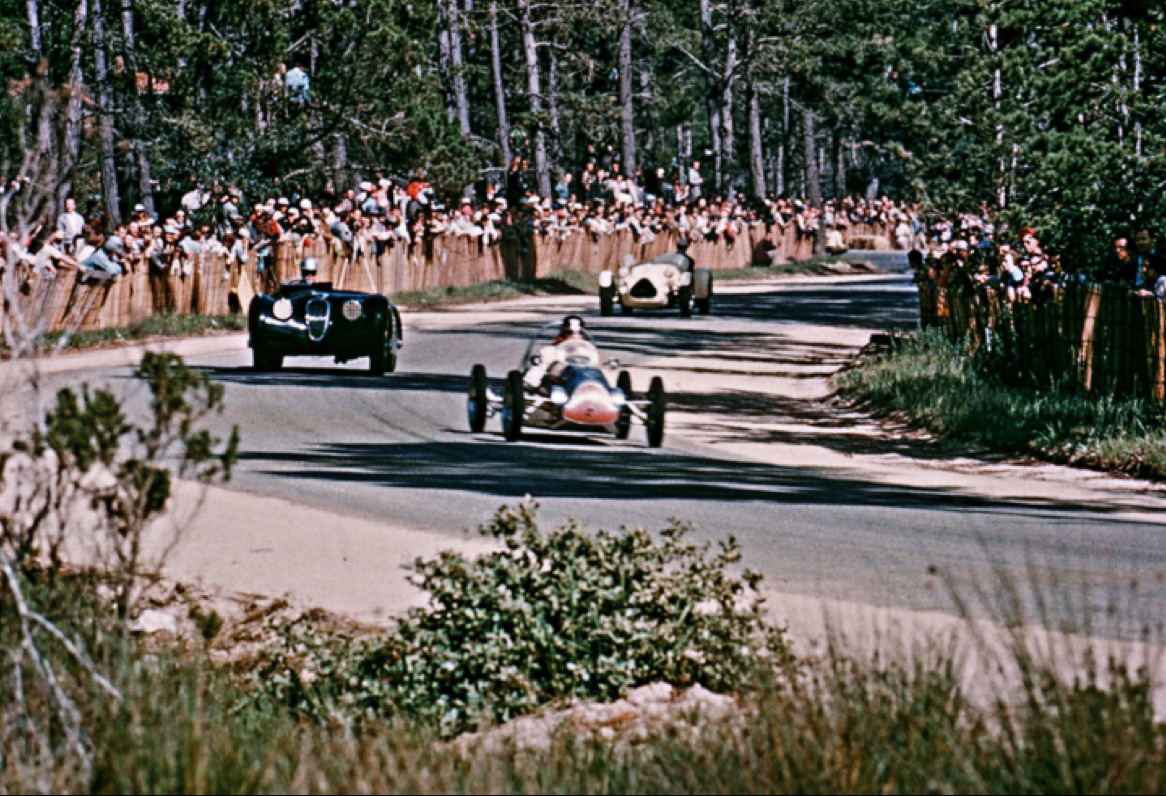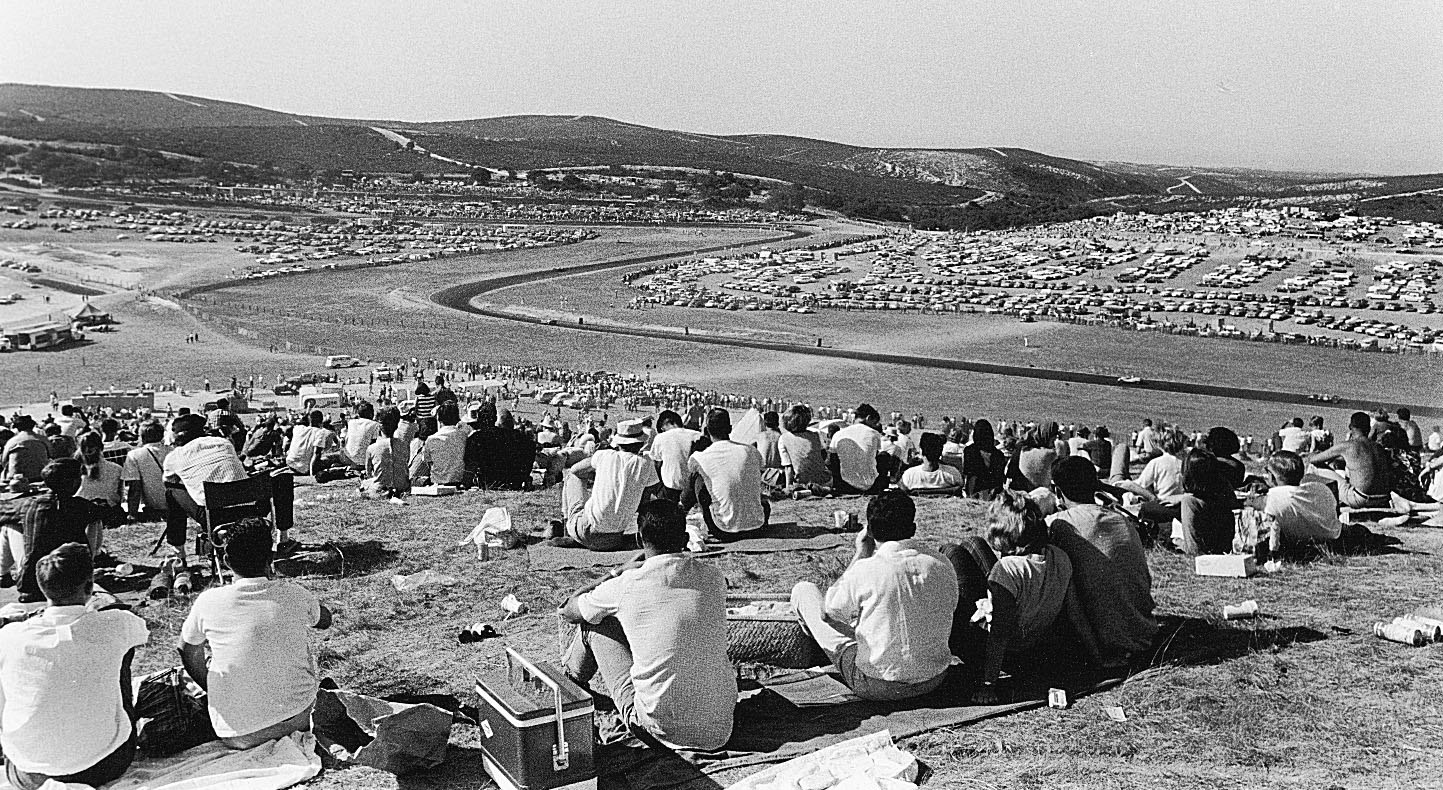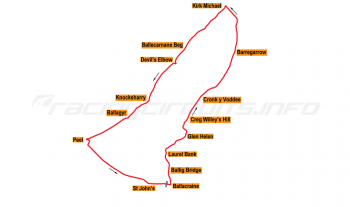Laguna Seca
Circuit Overview
Laguna Seca's classic road course (now known as WeatherTech Raceway Laguna Seca for marketing reasons) winds its way around the hillsides on the Monterrey Peninsula and has long been considered one of America's best.
Relatively short but fast, the course features considerable elevation changes, notably the downhill plunging 'Corkscrew' turn, which is perhaps one of the most recognisable turns in world motorsport.
The course hosts annual visits for both the IndyCar Series, the IMSA WeatherTech Sportscar Series and MotoAmerica, as well as several popular historic racing meetings.
Circuit History
Laguna Seca Raceway’s origins lie in the sports car races held at Pebble Beach in the 1950s, which used public roads through the Del Monte pine forests. These were hugely popular events attracting up to 50,000 spectators, who lined the forested roads to get a glimpse of the speeding cars passing by. Managed under the auspices of the SCCA (Sports Car Club of America), the Pebble Beach events began in 1950 with racers competing for the Del Monte Trophy.

The races escaped serious incidents for a number of years but the rising speed of the cars saw danger increase in equal measure. The good fortune ran out during practice for the 1956 event, when the Triumph of Warren Frinchaboy left the road and ran into a tree, leaving the driver with serious injuries. It was a portent of worse to come.
Just a few days later in the race for over 1550cc non-production cars, experienced racer Ernie McAfee misjudged the entry to the sixth turn, clipping a hale bale and sending his Ferrari careering off track and broadside into a tree, killing him instantly. Had it not been for the presence of the tree, the car would have rolled into a group of spectators.
A new course is needed
It was clear to all that safety had outgrown the forested roads, which were soon abandoned for racing. The Pebble Beach races had however demonstrated the popularity of racing and the financial impact it could have for the local community and local businesses leaders were keen to keep sportscar racing alive.
At the August 1956 meeting of the Monterey Special Events Committee, it was suggested that a permanent group be formed to find a way of ensuring the races could contine. This would ultimately become the Sports Car Racing Association of the Monterey Peninsula (SCRAMP), which was formed in mid-1957.
It was clear a permanent circuit was required and the obvious place on which to locate it seemed to be the nearby military base, Fort Ord. However, the Defence Department were less keen, citing concerns about liability and worries that the public would not think it was a good use of a military reserve.
SCRAMP persevered and spent the next few months lobbying military bosses and California Congressional members to great effect, such that the Defence Department backed down and left the decision up to the base commander. The marvellously-named Major General Gilman Mudgett was duly talked into agreeing that land on the eastern side of the post could be used for racing, with the stipulation that a lease agreement should be drawn up between the military and Monterey Peninsula Chamber of Commerce.
In August 7, 1957, a five-year agreement worth $3,000 was duly signed by the Chamber, which then admitted the newly formed SCRAMP as a member to oversee the racing. Not lacking in ambition, SCRAMP then began the task of fundraising, while electing to announce that the first race would take place in November of the same year!
Organic origins of the course
Somewhat amazingly, they managed to pull it off. Raising $125,000 from public subscriptions, a nine-turn course was constructed in just 60 days. A number of factors were in SCRAMP’s favour. The parcel of land around a dry lake bed formed a natural bowl (Laguna Seca means dry lake in Spanish), which was great for spectating and also suggested a great deal of the layout for itself. The Granite Construction Company, a Californian-based road building firm, signed up to lay the track at cost, even agreeing to delay full payment.
Overseeing this work was a young Salinas architect, Wallace Holm, the Site Development and Maintenance Committee chair of SCRAMP. While responsible for deciding where the asphalt should be laid, it wasn’t until after this was complete that a track diagram was actually drawn up!
He explains: “Like many things that happen in life, the race track was created by committee. There were a lot of people working together negotiating deals and working out compromises.
“We were fortunate to have one of the best road builders in the world working with us. Not only were we running a cost-conscious endeavour, but we were building the track on the fly.
“The plans that I drew of the track weren’t drawn until after the track was completed. We literally drew a rough diagram in the dirt, staked it out, and the bulldozers moved in and went to work. Building less than two miles of road was not a monumental task because we knew where the track was generally going to be.”
Nevertheless, feedback was gained from racing drivers during the construction, with Holm conscious that he had no experience of designing circuits. This led to revisions to some of the original design when some of the turns, as originally conceived, were too dangerous.
One part of the course that was not subject to committee or driver input during its build was the now legendary ‘Corkscrew’ set of turns. Local folklore has it that the construction crew building that section of track were headed to lunch and the foreman simply told the bulldozer driver: “Get down the hill any way you can.” The result was the plunging roller coaster ride we are now familiar with today.

Circuit opens to great fanfare
SCRAMP’s gamble to build the circuit quickly paid off when 35,000 paying spectators turned out for its inaugural race, an SCCA National event, which also counted as part of the Pacific Coast Championship. Major General William M. Breckenridge from Fort Ord and SCRAMP President Lou Gold cut the ribbon on November 9, 1957, to officially declare the facility open for business.
First past the chequered flag and into the history books the next day was Pete Lovely, who took his Ferrari 500 TR to victory at an average speed of 80.19 mph.
The drivers found a fast course which climbed the hillside to its signature turn, a left-right chicane which sweeps down the hillside in spectacular style. It very quickly earned the nickname ‘The Corkscrew’.
The natural bowl of the circuit meant that spectators got great views of the action from the hillsides, with around 90 percent of the course visible from all points.

Understanding “The Corkscrew”
Some corners can appear a lot flatter to the eye than is actually the case, but not so the Corkscrew (officially named Turns 8 and 8A or Turn 6 and 6A on the original course). The change in elevation here is startling: at the apex of the left-hand Turn 8, the road drops away by 12 percent. By the time you reach Turn 8A (the right-hander), the change in elevation is at its greatest; an 18 percent drop. In total, the course drops 59 feet between the entrance of Turn 8 to the exit of Turn 8A — the equivalent of a 5½ storey building — in only 450 feet of track length.
It was here that Alex Zanardi pulled off his audacious, four-wheels-in-the-dirt passing manoeuvre on the last lap of the 1996 CART IndyCar race to take victory and seal his place in US racing folklore. Valentino Rossi performed a similar manoeuvre in the 2008 US MotoGP race to best Casey Stoner and achieve his own ‘King of the Corkscrew’ legendary status.
Despite appearances, however, The Corkscrew is not the biggest change in elevation on the course: from Turn 8 to Turn 9, the track drops 109 feet, or just over 10 stories. The major difference, however, is that it does this over a much longer distance, so it its significance is less noticeable.
Sportscar racing has always been a mainstay of the action, with the Grand Prix of Monterey being a seasonal highlight, usually rounding off the racing year. The event began as a USAC Road Racing Championship race in 1960 until that series petered out three year’s later. It continued as a non-championship sportscar race until the arrival in 1966 of the thunderous Can-Am cars. The sight and sounds of the untamed McLarens, Chaparrals and Porsches of the day must have made quite an impression on race goers.
After the demise of Can-Am in 1974, the event shifted to Formula 5000 for two years, then to IMSA for two more years, before the revived Can-Am series returned in 1978. In 1983 it switched away from sportscars, with the arrival of the CART IndyCars, which it hosted all the way through to 2004, usually as the season finale.
The circuit has also traditionally hosted a separate Spring sportscar race, known as the Course de Monterrey. This began in 1963 as part of the SCCA’s new United States Road Racing Championship. The race fell dormant in 1969 but was revived in 1973 with the arrival of IMSA GT Championship.
Between 1999 and 2013 the event was a part of the American Le Mans Series, until the series merged with the Rolex Sports Car Series in 2014 to form the United SportsCar Championship (now the IMSA WeatherTech SportsCar Championship) where it remains on the calendar to this day.
Motorbikes bring track changes
It’s not just four-wheeled action that has found a home on the Monterrey Peninsula. Motorcycle racing has long been a key part of the track’s activities and indeed has influenced many of the major changes the track has undertaken.
The AMA began holding the forerunner of the current MotoAmerica series for superbikes at the track in 1976 and the event helped grow the circuit’s reputation in the two-wheeled sport considerably. By 1988, it was deemed a suitable venue to revive the dormant US Grand Prix as part of the FIM World Motorcycle Championships, after a 23 year absence from the calendar.
To achieve this, a new infield loop was added to the track in order to ensure the circuit met FIM minimum lap length requirements. The old Turn Two left-hander was turned into an 18-degree hairpin, with new series of corners around the old lake bed before returning at a tightened curve at the old Turn 3. This extended the track from its original 1.9-mile length to 2.214-miles.
The 125cc bikes were not present, leaving races for 250cc and the main 500cc class. It was perhaps not the best organised event of the year and was marred by concerns from the non-US riders about safety. In particular, the section leading up to the Corkscrew was felt to be too bumpy for Grand Prix machinery, while there were also concerns about the closeness of the barriers and concrete walls around the track.
"Laguna Seca’s place in history is in line with Monza, Nürburgring, Silverstone and other iconic racetracks in the world. I’ve traveled all over the world racing and motorsport enthusiasts everywhere know Laguna Seca and the Corkscrew. Laguna Seca is a place where all the greats have raced and for me it sits at the top of the list."
Ahead of the 1989 race, the bumps were addressed to some degree, but the dangers of the close barriers remained, leading to continued criticism from the riders. Sadly, this proved justified when Wayne Gardner broke a leg in a heavy crash at Turn 5. An ambulance was dispatched on course to retrieve him, without yellow flags being shown to the riders, which could easily have proved disastrous.
There was in any case a further serious incident at the end of the race, when Bubba Shobert slammed into the back of Kevin Magee’s bike at high speed, after the Australian rider had stopped to do a burnout in the middle of the track after a blind crest. Magee suffered a broken ankle and leg but Shobert’s serious head injuries ended the American’s riding career.
Further track improvements were made for the 1990 race to increase run-off’s and move back some barriers, but still the grumbles continued from riders. The race was actually dropped from the calendar in 1992 when F1 impresario Bernie Ecclestone was briefly involved in organising the series, but was restored the following year when the Spanish Dorna organisation took over the reigns. However, the race was dropped in 1995 due to financial problems and complaints from riders about the dangerous circuit.
What's in a name?
The track is officially known as the WeatherTech Raceway Laguna Seca, after a multi-year sponsorship deal was signed in 2018. Previously, the circuit had enjoyed a long relationship with car builder Mazda, which had led to it being named Mazda Raceway Laguna Seca for some 17 years. To most fans, it remains simply Laguna Seca, however.
More changes come to boost safety
The World Championship stars may have moved on but there was still top level two-wheeled competition at Laguna Seca, with the arrival of the World Superbike Championship in 1995. This proved to be a happier affair, though there were still calls for further safety upgrades. In response, the Turn 9-10-11 section was re-profiled for 1996, with the effect of slightly extending the start-finish straight and extending the run-off for the final turns.
Further upgrades, funded by Yamaha, were made in time for 2005, mainly altering run-offs and ensuring the circuit was ready to host the MotoGP circus, which had agreed to return. Californian environmental legislation meant that only the 4-stroke MotoGP bikes were allowed to participate. The local crowds were rewarded with a win for American Nicky Hayden, who celebrated by taking his father Earl around the track on the back of his bike.

An additional $7 million of improvements were made in 2006 with the aim of further boosting safety and facilities for the two-wheeled brigade. The biggest change came from Turn Six to the Corkscrew, with run-off added to both sides of the straightaway, with the dip just before the Corkscrew flattened. Meanwhile, the entire surface was repaved, while extra run-off was added at Turn One. This required removing a portion of the hillside as well as the former media centre building that sat atop it. A state-of-the-art hospitality centre with commanding views of the facility replaced it.
SCRAMP out and new management appointed
The good relationship between the Monterey County Board of Supervisors (which was deeded the ownership of the land from the military in 1974) and the non-profit SCRAMP organisation had been one of the strengths behind Laguna Seca’s success. By the 2010s, however, serious cracks had emerged in the relationship, to the extent that accusations of mismanagement were levelled against SCRAMP, which were apparently backed up by independent audits.
By 2015, the County elected to consider alternative operators for the track. Private talks were held with International Speedway Corporation (ISC) about taking over the management of the track, which eventually came to nought when ISC decided it would not be sufficiently profitable and declined to make any formal proposals. The following year the County Administrators Office entered into negotiations with another group to replace SCRAMP for 2017 but were unable to agree to terms that were mutually acceptable. This left it having to agree a new three-year lease through to the end of 2019 with SCRAMP, but it was clear the writing was on the wall.
Despite orchestrating a highly-successful return of IndyCars to Laguna Seca in 2019, SCRAMP found itself as one of three bidders to emerge as the chief runners for the new management contract. To industry surprise, the County Administrators Office elected in November 2019 to discount the bids from both SCRAMP and from Laguna Seca Management LLC, a group led by long-time racing promoter and motorsports industry veteran Chris Pook. Instead, the contract was awarded to a new company, A&D Narigi Consulting, LLC, which had no prior motorsports experience, though its founder John V. Narigi had 40 years of expertise in the hospitality industry.
As of January 1, 2020, A&D Narigi assumed the track’s management and promotion of major racing events. Talks then began to find a new volunteer organisation to take over the many marshaling and other event day duties that are the lifeblood of any circuit. In May 2021, it was announced that the newly-formed the Laguna Seca Volunteer Association had agreed a long-term deal with the Laguna Seca Recreation Area. The not-for-profit organisation included many of the former SCRAMP volunteers.

Jump onboard
Circuit info
- WeatherTech Raceway Laguna Seca, 1021 Monterey-Salinas Highway, Salinas, CA 93908 USA
- +1 831 242 8201
- Email the circuit
- Official website
Rate This Circuit
Votes: 7079
Plan a visit
Get your race tickets!
Brought to you with: 
We've teamed up with Motorsports Tickets to bring you the best deals for Formula One, MotoGP, Le Mans and more.
















